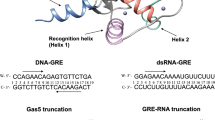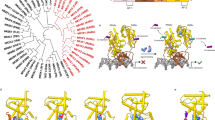Abstract
Members of the nuclear receptor (NR) superfamily of transcription factors modulate gene transcription in response to small lipophilic molecules1. Transcriptional activity is regulated by ligands binding to the carboxy-terminal ligand-binding domains (LBDs) of cognate NRs. A subgroup of NRs referred to as ‘orphan receptors’ lack identified ligands, however, raising issues about the function of their LBDs2. Here we report the crystal structure of the LBD of the orphan receptor Nurr1 at 2.2 Å resolution. The Nurr1 LBD adopts a canonical protein fold resembling that of agonist-bound, transcriptionally active LBDs in NRs3, but the structure has two distinctive features. First, the Nurr1 LBD contains no cavity as a result of the tight packing of side chains from several bulky hydrophobic residues in the region normally occupied by ligands. Second, Nurr1 lacks a ‘classical’ binding site for coactivators. Despite these differences, the Nurr1 LBD can be regulated in mammalian cells. Notably, transcriptional activity is correlated with the Nurr1 LBD adopting a more stable conformation. Our findings highlight a unique structural class of NRs and define a model for ligand-independent NR function.
This is a preview of subscription content, access via your institution
Access options
Subscribe to this journal
Receive 51 print issues and online access
$199.00 per year
only $3.90 per issue
Buy this article
- Purchase on SpringerLink
- Instant access to full article PDF
Prices may be subject to local taxes which are calculated during checkout





Similar content being viewed by others
References
Mangelsdorf, D. J. et al. The nuclear receptor superfamily: the second decade. Cell 83, 835–839 (1995)
Giguere, V. Orphan nuclear receptors: from gene to function. Endocr. Rev. 20, 689–725 (1999)
Moras, D. & Gronemeyer, H. The nuclear receptor ligand-binding domain: structure and function. Curr. Opin. Cell Biol. 10, 384–391 (1998)
Chawla, A., Repa, J. J., Evans, R. M. & Mangelsdorf, D. J. Nuclear receptors and lipid physiology: opening the X-files. Science 294, 1866–1870 (2001)
Kliewer, S. A., Lehmann, J. M. & Willson, T. M. Orphan nuclear receptors: shifting endocrinology into reverse. Science 284, 757–760 (1999)
Wisely, G. B. et al. Hepatocyte nuclear factor 4 is a transcription factor that constitutively binds fatty acids. Structure 10, 1225–1234 (2002)
Dhe-Paganon, S., Duda, K., Iwamoto, M., Chi, Y. I. & Shoelson, S. E. Crystal structure of the HNF4α ligand binding domain in complex with endogenous fatty acid ligand. J. Biol. Chem. 277, 37973–37976 (2002)
Law, S. W., Conneely, O. M., DeMayo, F. J. & O'Malley, B. W. Identification of a new brain-specific transcription factor, NURR1. Mol. Endocrinol. 6, 2129–2135 (1992)
Zetterstrom, R. H. et al. Dopamine neuron agenesis in Nurr1-deficient mice. Science 276, 248–250 (1997)
Saucedo-Cardenas, O. et al. Nurr1 is essential for the induction of the dopaminergic phenotype and the survival of ventral mesencephalic late dopaminergic precursor neurons. Proc. Natl Acad. Sci. USA 95, 4013–4018 (1998)
Le, W. D. et al. Mutations in NR4A2 associated with familial Parkinson disease. Nature Genet. 33, 85–89 (2003)
Castro, D. S., Arvidsson, M., Bondesson Bolin, M. & Perlmann, T. Activity of the Nurr1 carboxyl-terminal domain depends on cell type and integrity of the activation function 2. J. Biol. Chem. 274, 37483–37490 (1999)
Wurtz, J. M. et al. A canonical structure for the ligand-binding domain of nuclear receptors. Nature Struct. Biol. 3, 87–94 (1996)
Renaud, J. P. et al. Crystal structure of the RAR-γ ligand-binding domain bound to all-trans retinoic acid. Nature 378, 681–689 (1995)
Brzozowski, A. M. et al. Molecular basis of agonism and antagonism in the oestrogen receptor. Nature 389, 753–758 (1997)
Nolte, R. T. et al. Ligand binding and co-activator assembly of the peroxisome proliferator-activated receptor-γ. Nature 395, 137–143 (1998)
Greschik, H. et al. Structural and functional evidence for ligand-independent transcriptional activation by the estrogen-related receptor 3. Mol. Cell 9, 303–313 (2002)
Maruyama, K. et al. The NGFI-B subfamily of the nuclear receptor superfamily. Int. J. Oncol. 12, 1237–1243 (1998)
Darimont, B. D. et al. Structure and specificity of nuclear receptor-coactivator interactions. Genes Dev. 12, 3343–3356 (1998)
Pissios, P., Tzameli, I., Kushner, P. & Moore, D. D. Dynamic stabilization of nuclear receptor ligand binding domains by hormone or corepressor binding. Mol. Cell 6, 245–253 (2000)
Aarnisalo, P., Kim, C. H., Lee, J. W. & Perlmann, T. Defining requirements for heterodimerization between the retinoid X receptor and the orphan nuclear receptor Nurr1. J. Biol. Chem. 277, 35118–35123 (2002)
Laudet, V. Evolution of the nuclear receptor superfamily: early diversification from an ancestral orphan receptor. J. Mol. Endocrinol. 19, 207–226 (1997)
Escriva, H. et al. Ligand binding was acquired during evolution of nuclear receptors. Proc. Natl Acad. Sci. USA 94, 6803–6808 (1997)
Desclozeaux, M., Krylova, I. N., Horn, F., Fletterick, R. J. & Ingraham, H. A. Phosphorylation and intramolecular stabilization of the ligand binding domain in the nuclear receptor steroidogenic factor 1. Mol. Cell. Biol. 22, 7193–7203 (2002)
Renaud, J. P., Harris, J. M., Downes, M., Burke, L. J. & Muscat, G. E. Structure–function analysis of the Rev-erbA and RVR ligand-binding domains reveals a large hydrophobic surface that mediates corepressor binding and a ligand cavity occupied by side chains. Mol. Endocrinol. 14, 700–717 (2000)
Collaborative Computational Project Number 4 The CCP4 Suite: programs for protein crystallography. Acta Crystallogr. D 50, 760–763 (1994)
Terwilliger, T. C. & Berendzen, J. Automated MAD and MIR structure solution. Acta Crystallogr. D 55, 849–861 (1999)
De la Fortelle, E. & Bricogne, G. Maximum-likelihood heavy-atom parameter refinement for the multiple isomorphous replacement and multiwavelength anomalous diffraction methods. Methods Enzymol. 276, 472–494 (1997)
Jones, T. A., Zou, J. Y., Cowan, S. W. & Kjeldgaard M. Improved methods for building protein models in electron density maps and the location of errors in these models. Acta Crystallogr. A 47, 110–119 (1991)
Brunger, A. T. et al. Crystallography & NMR system: A new software suite for macromolecular structure determination. Acta Crystallogr. 54, 905–921 (1998)
Acknowledgements
We thank P. Cao for MS analysis, J. Lehmann, A. Shiau, B. Shan, C. Ibanez, A. Mata and Ö. Wrange for discussions and advice. This work was supported in part by the Göran Gustafsson Foundation, The European Union Research Training Network and the Swedish Foundation for Strategic Research. The Advanced Light Source at the Lawrence Berkeley National Laboratory is supported by the Director, Office of Science, Office of Basic Sciences, Materials Sciences Division, of the US Department of Energy.
Author information
Authors and Affiliations
Corresponding authors
Ethics declarations
Competing interests
The authors declare that they have no competing financial interests.
Rights and permissions
About this article
Cite this article
Wang, Z., Benoit, G., Liu, J. et al. Structure and function of Nurr1 identifies a class of ligand-independent nuclear receptors. Nature 423, 555–560 (2003). https://doi.org/10.1038/nature01645
Received:
Accepted:
Issue Date:
DOI: https://doi.org/10.1038/nature01645
This article is cited by
-
Potential Roles of Nr4a3-Mediated Inflammation in Immunological and Neurological Diseases
Molecular Neurobiology (2024)
-
The role of NURR1 in metabolic abnormalities of Parkinson’s disease
Molecular Neurodegeneration (2022)
-
A Nurr1 ligand C-DIM12 attenuates brain inflammation and improves functional recovery after intracerebral hemorrhage in mice
Scientific Reports (2022)
-
Prostaglandin A2 Interacts with Nurr1 and Ameliorates Behavioral Deficits in Parkinson’s Disease Fly Model
NeuroMolecular Medicine (2022)
-
Potent synthetic and endogenous ligands for the adopted orphan nuclear receptor Nurr1
Experimental & Molecular Medicine (2021)



